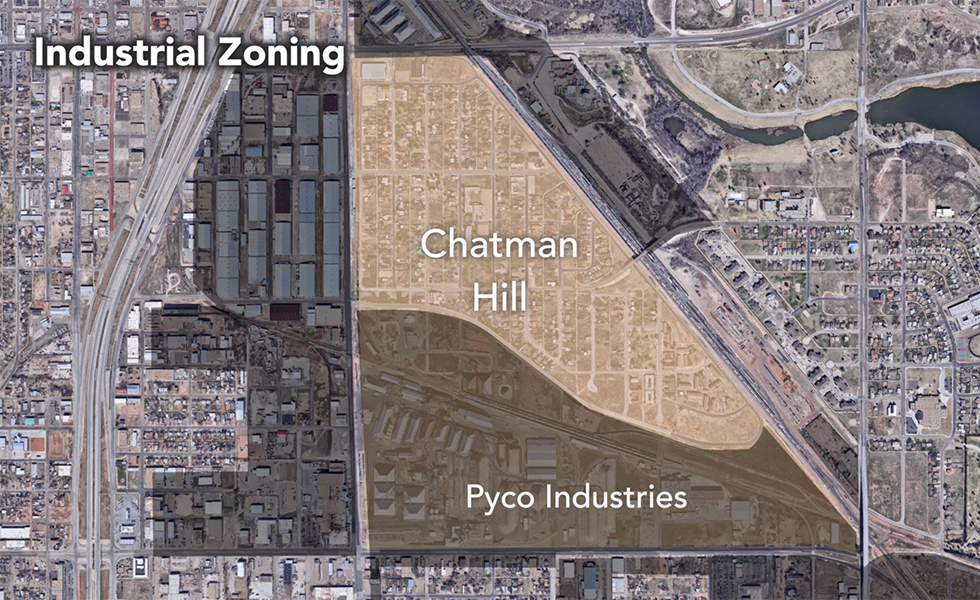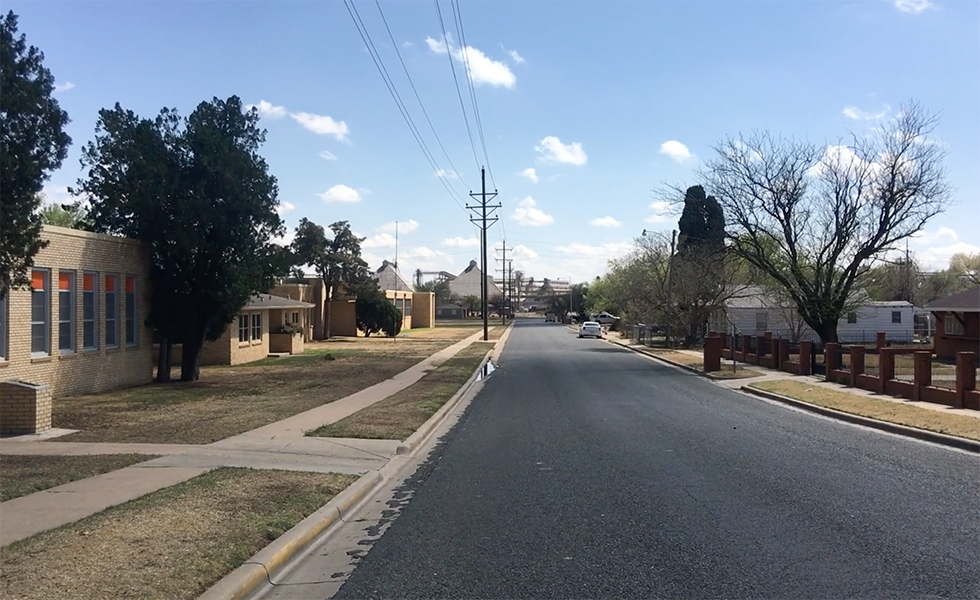A couple of years ago, Dianna Thomas spent a week away from her home in Lubbock’s Chatman Hill neighborhood. When she returned, she got into her car, which had been parked in the driveway, and found a thin film of grease on the glass windshield. “I was like, what in the world?” she says. She sat in her car for a moment before she realized it had come from the cottonseed oil mill four blocks from her house. “If that film is on my car, am I not breathing that in also?” she says.
Thomas, 76, grew up in the tight-knit neighborhood tucked behind Interstate 27 on Lubbock’s east side. The Pyco Industries oil mill has loomed over the area since before she was born—her father worked there, along with many of her neighbors. But in the late 1970s or early 1980s, she says, something changed—the mill started using chemicals that wafted over the neighborhood. “This has caused a lot of health problems for a lot of people that live in the area,” she says. “The air quality is very bad. If you go out at night and you look up, you can see a haze in the sky.”
In 2018, as Lubbock began the process of updating its comprehensive land use plan for the first time in 30 years, Thomas joined neighbors and activist groups asking the city to remove industrial zoning from East and North Lubbock, where most of the city’s black and Hispanic residents live. While 52 percent of Lubbockites are white, according to the U.S. Census, 71 percent of Chatman Hill’s residents are black. In North Lubbock’s Guadalupe neighborhood, 80 percent of residents are Hispanic.
Despite hundreds of written and oral comments submitted to the city regarding its zoning practices, on December 17, 2018, Lubbock City Council adopted Plan Lubbock 2040. This vision for the city’s future development leaves Lubbock’s zoning essentially unchanged, with industrial uses concentrated in and around majority black and Hispanic neighborhoods.

Now, two advocacy groups are claiming Lubbock’s land use practices violate the Fair Housing Act. In December 2019, Texas Housers, an affordable housing nonprofit, and the Lubbock NAACP filed a complaint with the U.S. Department of Housing and Urban Development (HUD) alleging that the City of Lubbock had continued discriminatory land use practices by allowing industry to continue to operate and expand in Lubbock’s East and North sides, disproportionately burdening neighborhoods of color “with environmental hazards and high-nuisance facilities.”
Those hazards include noxious fumes and air pollution, which residents say is hazardous to their health. About a decade ago, Thomas was diagnosed with chronic obstructive pulmonary disease (COPD), an inflammatory lung disease that makes it difficult for her to breathe without oxygen. “Why are so many people in this area on oxygen? Why are so many people in this area complaining of respiratory conditions?” she asks. “It has to be something in the environment that is causing that.” When she’s in West Lubbock, she says, she has no problem breathing. “But as soon as I come over here, I start getting congested.”
According to an analysis by Texas Housers, nearly all of the EPA’s toxic release inventory sites in Lubbock are within or adjacent to majority black or Hispanic neighborhoods—of the 20 businesses that require oversight by the EPA, 17 are located in East or North Lubbock.
In her living room in North Lubbock’s Guadalupe neighborhood, Dora Cortez, 69, just has to look out the window to see the industry that surrounds her, including a cement plant where concrete is batched and crushed, releasing dust particles into the air. “You can smell it and see it every single day,” she says. Her mom, who died last year, also had COPD, which Cortez attributes in part to the air pollution that plagues the neighborhood. “We’re so frustrated that we’re still—1943 to now—we’re still living in the neighborhoods where industry just prevails, that continues to expand, that continues to build,” she says.
Lubbock’s zoning practices are “rooted in Jim Crow segregation,” says Adam Pirtle, a fair housing lawyer at Texas Housers and a co-author on the complaint. In 1923, Lubbock’s city council adopted an ordinance that forbade black residents from owning property or residing anywhere outside of the neighborhood south of 16th Street and east of Avenue C, today’s Interstate 27. “In every subsequent land use plan the city has created, starting in 1943, they’ve surrounded that community with industrial zoning and heavy industry,” Pirtle says. “The Lubbock 2040 Plan basically leaves that racist system in place.”
The 1968 Fair Housing Act prohibits explicit acts of housing discrimination—refusing to rent or sell a dwelling to someone because of their race, for example, or because they have children. But it also includes a provision that obligates cities and other jurisdictions to take meaningful action to overcome historic patterns of segregation. This rule, known as Affirmatively Furthering Fair Housing, requires cities to periodically complete an Analysis of Impediments (AI) to fair housing and create a plan for how to correct them.
“Part of HUD’s rationale for making jurisdictions do an AI is to eliminate the vestiges of Jim Crow segregation when the government restricted the housing choices of people of color and denied their communities essential services and protections, like zoning protection from industrial uses,” Pirtle says. Including a barrier in the AI represents a “meaningful promise” to correct it in the future, he says. If a city doesn’t take steps to address it, HUD can withhold federal grant funding, which in Lubbock accounts for more than $3 million of the city’s annual budget.
Despite protests from Pirtle, neighborhood associations, and activists with the Lubbock NAACP, the City of Lubbock’s 2018 AI does not mention the city’s zoning practices as an impediment to fair housing. If the city won’t change its land use map, Pirtle says, it should at least recognize that concentrating industrial zoning in historically black and Hispanic communities effectively concentrates opportunity in some neighborhoods and removes it from others.

“I don’t understand how they can say that we are part of the city when they’re not even trying to change any of the land use map here in North and East Lubbock,” Cortez says. She was one of hundreds of residents who attended public meetings and submitted written comments requesting that the city start to transition industrial development outside the city. “The industry continues to expand. It’s like beating a dead horse. They listen to us, but then they don’t do anything about it,” she says.
Lubbock Mayor Dan Pope declined to be interviewed but offered a written statement that said, in part, that the Lubbock 2040 Plan “is the result of tremendous public input and represents a path forward for our community.” He wrote that members of the public were part of Plan Lubbock 2040’s development and that city council also appointed a public oversight committee. Karen Murfee, the City of Lubbock’s director of community development, did not respond to multiple interview requests from the Observer.
Natalie Ayers, 41, grew up in Parkway-Cherry Point, northwest of Chatman Hill. When she left Lubbock to join the military, she said she’d never return. “As luck would have it, I came back,” she says. When she returned in 2013, she noticed that her neighborhood “seemed a little bit more downtrodden.” There was no bank, few restaurants. Property values were declining. “Drive through the city, you can see certain neighborhoods flourishing with restaurants and banks and department stores,” she says. “As you move close to North and East Lubbock, it starts to diminish. You think: Why is that? Businesses aren’t interested in investing in areas where there is industrial zoning. It just doesn’t make business sense.”
“When I speak to those who have been in the community even longer than me, they say, ‘Yeah, that’s how it’s always been,’” she says. “It’s as if North and East Lubbock have been forgotten.”
Read more from the Observer:
-
The Fantastic World of Cande Aguilar: The wildly imaginative Brownsville painter fuses pop culture with abstraction, family life, and his love of South Texas.
-
Why a Small Offense Shouldn’t Have Life-Altering Consequence: Nearly 10 years ago, I was arrested and detained in jail for 45 days after failing to appear in court for a low-level, non-violent offense. Today, I’m fighting so that others don’t have to go through what I did.
-
Federal Report Flags High Rates of Sexual Abuse in Texas Juvenile Lockups: In three Texas youth prisons, at least one in seven juveniles says they’ve been sexually victimized, according to a new report from the U.S. Department of Justice.







